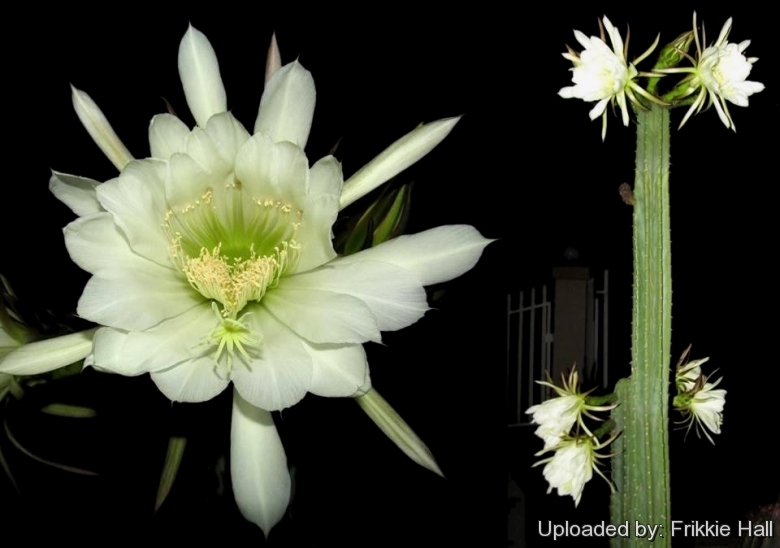
Echinopsis pachanoi Photo by: Frikkie Hall
Origin and Habitat: Mountains of Peru, Ecuador, Bolivia and northern Argentina. It is subspontaneous in several South American and in some tropical countries in other continents.
Altitude: It grows between 1500 and 3300 metres above sea level.
Habitat: Echinopsis pachanoiSN|8470]]SN|8470]] has a wide distribution and stable population. It grows naturally in the high altitude dry shrublands and high rainfall areas of the Andes. It can withstand temperatures far below that of many other cacti. This cactus is frequently sold as an ornamental and for rituals. Some specimens are extracted from the wild, but it is also cultivated. San Pedro is a fast-growing cactus.
Synonyms:
See all synonyms of Echinopsis pachanoi
back
Accepted name in llifle Database:Echinopsis pachanoi (Britton & Rose) H.Friedrich & G.D.RowleyI.O.S. Bull. 3(3): 96. 1974Synonymy: 9
Cultivars
(1):
back
Common Names include:
ENGLISH: San Pedro Cactus
DUTCH (Nederlands): San Pedro-cactus
ESTONIAN (Eesti): San-Pedro siilikkaktus
FINNISH (Suomi): Kynttiläkaktus
FRENCH (Français): Cactus San Pedro
GERMAN (Deutsch): San-Pedro-Kaktus
HUNGARIAN (Magyar): San Pedro-kaktusz
ITALIAN (Italiano): San Pedro
LATVIAN (Latviešu): Sanpedro kaktuss
LITHUANIAN (Lietuvių): Kvaitulinis echinopsis
POLISH ( Polski): San pedro kaktus, San pedro
PORTUGUESE (Português): Wachuma, São Pedro
QUECHUA (Runasimi / Qhichwa simi): San Pidru, Achuma, Sanpidru wachuma, Wachuma
RUSSIAN (Русский): Сан-Педро, Кактус Сан-Педро
SPANISH (Español): Sanpedrillo, Olala, Huando hermosa, Huando, Huacuma, Curi, Cardo, Cactus Real, Agua-collo, Huachuma, Gigantón, Símora, San Pedrillo, Huando hermoso, Huachumo, Cuchuma, Cimora blanca, Cimarrón, Cardon, Andachuma, Cardón santos, San Pedro, Cactus de San Pedro, Achuma, Aguacolla
UKRAINIAN (Українська): Кактус Сан-Педро
Description: Large, multi-stemmed fast-growing columnar cactus. Forms a small tree 3 to 6 meters tall by 1,8 m spread, with several branches, usually extending from the base.
Stem: Upright columnar and flexible, pale green to blue-green, slightly glaucous when young, dark green in age. Up to 6 m tall, 6-15 cm in diameter.
Ribs: 4-8, (usually 5-7) broad at base, obtuse, rounded, with a deep horizontal depression above the areole.
Areoles: Whitish, close set.
Spines: Highly variable, often wanting, when present few (3 to 7), unequal, the longest 1 to 2 cm. long, dark yellow to light brown. Spines are located at the nodes which are spaced evenly (approximately 2 cm apart) along the ribs.
Flowers: Very large, white, night blooming and remaining open for the following day, fragrant, up to 22 cm in diameter. They are very showy. Inner perianth segments white, outer segments brik red, stamen filaments greenish. In this species, the flowers buds are produced from the spine clusters along the margins near the top of branches. The buds are pointed. Flowers tube, and fruits are covered with scales and black curled hairs.
Blooming time: July.
Fruit: Oblong, dark-green, 5-6 cm long, 3 cm in diameter.
Remarks: The San Pedro cactus (Echinopsis pachanoiSN|8470]]SN|8470]]) is often confused with its close relative, the Peruvian Torch cactus (Trichocereus peruvianusSN|8638]]SN|8638]]) which contains small quantities of mescaline, a hallucinogenic drug.
Subspecies, varieties, forms and cultivars of plants belonging to the Echinopsis pachanoi group
Bibliography: Major references and further lectures
1) Curt Backeberg “Die Cactaceae: Handbuch der Kakteenkunde.” Volume 3, 1959
2) Ostalaza, C., Cáceres, F. & Roque, J. 2013. Echinopsis pachanoi. In: IUCN 2013. "IUCN Red List of Threatened Species". Version 2013.2. <www.iucnredlist.org>. Downloaded on 29 March 2014.
3) Britton & Rose "The Cactaceae" 4: 273, 1923
4) Edward Anderson “The Cactus family” Timber Press, Incorporated, 2001
5) James Cullen, Sabina G. Knees, H. Suzanne Cubey "The European Garden Flora Flowering Plants: A Manual for the Identification of Plants Cultivated in Europe, Both Out-of-Doors and Under Glass" Cambridge University Press, 11/Aug/2011
6) David R Hunt; Nigel P Taylor; Graham Charles; International Cactaceae Systematics Group. "The New Cactus Lexicon" dh books, 2006
7)Dobkin de Rios, M. “Trichocereus Pachanoi: a Mescaline Cactus Used in Folk Healing in Peru.” Economic Botany 22 (1968): 191–194.
8) Cordy-Collins, A. “Psychoactive Painted Peruvian Plants.” in: Journal of Ethnobiology 2, no. 2 (1982): 144–153.
9) Torres, D., and M. “San Pedro in the Pressure Pot.” Yearbook for Ethnomedicine and the Study of Consciousness 1995, no. 4 (1996): 283–284.
10) Davis, E.W. “Sacred Plants of the San Pedro Cult.” Botanical Museum Leaflets 29, no. 4 (1983): 367–386.
11) Hofmann, A., Ratsch, C., Schultes, R., “Plants of the Gods: Their Sacred, Healing, and Hallucinogenic Powers.” Rochester: Healing Arts Press, 1992.
12) Furst, P.T. “Shamanism, Transformation, and Olmec Art.” In The Olmec World: Ritual and Rulership. Princeton, N.J.: The Art Museum, Princeton University, 1996.
13) Polia, M., and A. Bianchi. “Ethnological Evidences and Cultural Patterns of the Use of Trichocereus Pachanoi Britt. Et Rose Among Peruvian Curanderos.” Integration 1 (1991): 65–70.
14) Ratsch, Christian., “The Encyclopedia of Psychoactive Plants: Ethnopharmacology and its Applications.” Rochester: Park Street Press, 1998.
15) 1) Forest & Kim Starr Echinopsis pachanoi (San Pedro cactus). Plants of Hawaii. <http://www.starrenvironmental.com>. Downloaded on 22 August 2014.
 Echinopsis pachanoi Photo by: Frikkie Hall
Echinopsis pachanoi Photo by: Frikkie Hall Habit at Lualailua, Maui, Hawaii (USA). March 20, 2007 Photo by: Forest Starr & Kim Starr
Habit at Lualailua, Maui, Hawaii (USA). March 20, 2007 Photo by: Forest Starr & Kim Starr Habit at Lualailua, Maui, Hawaii (USA). March 20, 2007 Photo by: Forest Starr & Kim Starr
Habit at Lualailua, Maui, Hawaii (USA). March 20, 2007 Photo by: Forest Starr & Kim Starr Echinopsis pachanoi Photo by: Frikkie Hall
Echinopsis pachanoi Photo by: Frikkie Hall Echinopsis pachanoi Photo by: Frikkie Hall
Echinopsis pachanoi Photo by: Frikkie Hall Echinopsis pachanoi Photo by: Frikkie Hall
Echinopsis pachanoi Photo by: Frikkie Hall Echinopsis pachanoi Photo by: Frikkie Hall
Echinopsis pachanoi Photo by: Frikkie Hall Echinopsis pachanoi Photo by: Cactus Art
Echinopsis pachanoi Photo by: Cactus ArtCultivation and Propagation: Trichocereus pachanoiSN|6864]]SN|8471]] is very easy to grow and cold hardy.
Growth Rate: It produces prodigious amounts of growth each year if kept well fed and watered throughout the warmest months, particularly if it has been acclimatised to accept full sun. Once this cactus is established it can easily produce 30cm of growth every year.
Soils: It needs a fertile, well drained soil mix.
Repotting: Use pot with good drainage.
Watering: Water the plants well and allow them to dry before watering again. This species seems to do better with a little more water than most cacti. In fact, its cultivation requirements are really more like 'normal' plants than most other cacti, keep dry in winter or when night temperatures remain below 10° C. Water it less than average if in bigger pots.
Fertilization: During the growing season fertilize them monthly with a balanced fertilizer
Hardiness: Trichocereus pachanoiSN|8309]]SN|8471]] is very easy to grow and cold hardy as low as -12°C (or less). Assure a good ventilation.
Exposition: Outside full sun, but during hot summers the cactus are subject to sun burning, so grow them in light shade. Inside they need bright light, and some direct sun. During winter months, put them in a cool luminous place and encourage them to enter winter dormancy by withholding water and fertiliser over the winter, as they will etiolate, or become thin, due to lower levels of light..
Pests & diseases: They are susceptible to fungal diseases if over-watered, but are not nearly as sensitive as many other cacti, especially in warm weather. They tend characteristically towards black rotted spots unless watering is moderate and only in hot weather. If kept damp through cold periods, they will invariably suffer.
Ornamental usess: Often cultivated for hedges and also planted as ornamental worldwide in tropical climate gardens .
Grafting stock: It is commonly suggested as a universal grafting stock and is widely grown for this purpose. It is by far one of the best and hardy root stocks for smaller, slower, low-growing cacti often seen as the base stock in photographs within numerous publications. Several others of the Trichocereus species also work well as fast growing columnar stocks, and have a good success rate for lasting a long time. Some forms of Trichocereus bridgesiiSN|8750]]SN|7567]], Trichocereus peruvianusSN|8638]]SN|8638]], T. spachianus and faster growing strains of Trichocereus werdermannianusSN|7567]]SN|8750]] will also work well. Trichocereus macrogonusSN|8471]]SN|8309]] and Trichocereus pasacanaSN|8471]]SN|6864]] are often recommended for colder climates and for grafting species of cold hardy scions. Scions grafted on Trichocereus might initially take slightly longer to begin their growth burst (when compared to other grafting stocks), but usually have a very good life span of steady fast growth.
Hallucinogenic drug: The young stems are chopped because of their alkaloid content and frequently sold in the markets in Ecuador, north Peru and Bolivia. The indigenous people of the andes recognize several “kinds” of San pedro, distinguished by the number of ribs. Cacti with seven ribs are the least potent and most common. Cacti with four ribs are rare, considedered the more potent and belived to have special power because each rib correspond with one of the “four winds”. The four winds and the four roads are supernatural powers associated with the four cardinal directions. It is still used in present days by shamans and folk healers. The use of this plant date back to 3000 yeas ago.
Propagation: By cutting or from seed. The seeds are quite easy to germinate and grow. Their main requirements consist of high humidity levels, free-draining soil mix, and enough water, light, and nutrition.
Your Photos
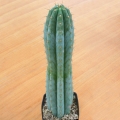
by Valentino Vallicelli
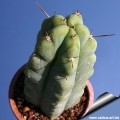
by Cactus Art
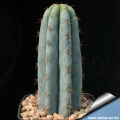
by Cactus Art

by Forest Starr & Kim Starr
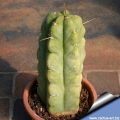
by Cactus Art























